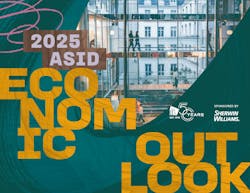Key takeaways:
- Embrace market diversification.
- Leverage the circular economy for cost management.
- Invest in future-focused skills during downturns.
Why we think this is important to design professionals: The interior design industry is facing a tough year ahead with clients tightening budgets and material costs climbing. But here’s the thing: Firms that get creative with their approach right now are going to come out stronger on the other side. While others are just waiting it out, you can be building the skills and strategies that’ll set you apart when the market bounces back.
Research for the 2025 ASID Economic Outlook was conducted by economist Bernard Markstein, Ph.D., and ASID Research Fellow S. Dawn Haynie, Ph.D., with contributions by ASID Director of Communications Lindsey Koren. The report is sponsored by Sherwin-Williams.
In the second installment of its 2025 Outlook research series, the American Society of Interior Designers (ASID) urges the interior design community to consider “embracing...blurred lines” between conventional architecture and construction market sectors to “reimagine what options your company can pursue to remain viable” in the face of unpredictable economic conditions.
ASID’s mid-spring comments to i+s regarding tariffs, trade policy, and the potential specification trade-offs for designers remain largely relevant with regard to the final Economic Outlook report, so we won’t repeat them here. ASID does an outstanding job outlining economic and policy influences in detail, so we encourage you to get your hands on the full Economic Outlook from their website.
Having said that, the report encourages designers to remain agile and establish a diverse strategy in order to offset the slowing demand for services across multiple markets, which is expected to persist through much of 2025 due to high interest rates, federal funding limitations, and inflation- and trade-policy induced pricing pressures.
In keeping with the first 2025 Outlook report’s angle of meaningful design narrative, well-being, and purpose, let’s take an empowered “challenge/response” approach to addressing some of the top industry concerns.
Challenge: “[Anticipated] price hikes on furniture and fixtures due to tariffs.”
Response: While there are certainly still plenty of supply options to consider for interior product specification, one solution may lie within the secondhand marketplace. Consider a plan that includes vetting one-of-a-kind finds from local used furniture dealers, established online resellers, and direct refurbishment services through well-known manufacturers that offer expansive warranties on existing product.
Dealers for manufacturers such as HON Furniture, Steelcase, and Humanscale are just a few of the vendors who offer inclusive warranties and/or restoration services to ensure that circularity becomes the standard whenever possible. RESEAT, which began as an online marketplace for buying and selling used furnishings, now enables customers to manage their existing inventory and include digital product passports for tracking sustainability.
Challenge: “Suppressed demand” for interior design services foreseen through 2025.
Response: During a period of uncertainty, we know it pays to manage costs. But also consider investing wisely in securing your future foothold. Firms looking to elevate their talent base and skillsets can access any number of resources through the industry associations. IIDA’s Certified Design Futurist program offers coursework to help designers harmonize trend forecasting, evolve their design practice, and leverage technology to streamline processes, so they can demonstrate resiliency and adaptability to market fluctuations. ASID offers tools for succession planning, and BIFMA knows a thing or two about applying lessons learned from the pandemic to ensure a thriving and engaging workplace.
Challenge: New public infrastructure projects hang due to cutbacks, commercial office market remains soft.
Response: As ASID’s researchers note, in short: Diversify. In more verbose terms, seek out new locations, markets, and conversion or adaptive reuse opportunities. The latter, in particular, serves multiple agendas for clients such as municipal planners, facilities owners, and real estate property developers. Gensler’s Dayita Kumar recently wrote that redevelopment opportunities are growing in suburban areas that were once full of siloed plazas and parking lots. Kumar said the architectural firm is finding clients have a greater willingness to plan conversions “with reduced project budgets, tight timelines, and an increased focus on sustainability,” rather than navigate the uncertainty of new construction and the associated costs.
In an episode of our I Hear Design podcast, Marissa Kasdan and Mark Oberholzer of AEC firm KTGY spoke to Robert Nieminen about the risks and the rewards of adapting former commercial buildings into residential and mixed-use facilities. In explaining their approach to converting 30-to-40-story steel-framed towers, Kasdan and Oberholzer identified code updates, structural challenges, and cost implications with the ageing building type. They analyzed the obstacles and opportunities and landed upon a framework for the “Upcycle Tower” that could reshape the landscape of urban real estate.
By embracing circularity, diversifying your practice, and investing in future-focused skills, you’re not just surviving 2025’s challenges; you’re positioning yourself to thrive when the market rebounds.
*An edited version of this story appeared in the July/August 2025 issue of i+s.
About the Author
Carrie Meadows
Editor-in-Chief
Carrie Meadows is Editor-in-Chief of interiors+sources (i+s), where she leads editorial strategy, content development, and brand storytelling focused on the people, projects, and innovations shaping the design industry. With more than two decades of experience in B2B media, she has built a career connecting technical expertise with creative insight—translating complex topics into meaningful stories for professional audiences. Before joining i+s in 2024, Carrie served as Editor-in-Chief of LEDs Magazine within Endeavor Business Media’s Digital Infrastructure & Lighting Group, guiding coverage of emerging lighting technologies, sustainability, and human-centric design. Her earlier editorial experience spans across Laser Focus World, Vision Systems Design, Lightwave, and CleanRooms, where she managed print and digital publications serving the optics, photonics, and semiconductor sectors.
An advocate for clear communication and thoughtful storytelling, Carrie combines her editorial management, SEO, and content strategy expertise to help brands and readers stay informed in a rapidly evolving media landscape. When she’s not crafting content, Carrie can be found volunteering at a local animal shelter, diving into a good crime novel, or spending time outdoors with family, friends, and her favorite four-legged friends.


